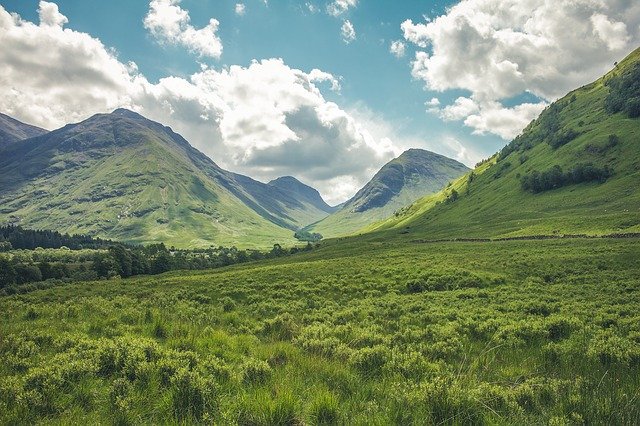Good for pressed flowers
Sun Needs
Full Sun
Soil Needs
Well-drained
Zones
5 – 8
Height
1 – 1.5 feet
Blooms in
Mid-Summer – Late Summer
Features
Good for pressed flowers
Sunflower
Known for their tall stalks and bright yellow petals, the Sunflower is an all time classic wildflower. They most commonly come in yellow, but Sunflowers can also be found in rich orange and red hues.
Sun Needs
Full Sun
Soil Needs
Well-drained
Zones
3 – 10
Height
1 – 3 feet
Blooms in
Early Summer – Early Fall
Features
Good for cut flowers
Sweet Alyssum
The genus name for Sweet Alyssum comes from the Greek word “small pod,” referring to the shape of its fruits. Its flowers come in violet, white or pink hues and its creeping habit make it useful for filing gaps in pathways or stone walls.
Sun Needs
Full Sun?/?Partial Shade
Soil Needs
Damp
Zones
7 – 11
Height
0.2 – 1 foot
Blooms in
Late Spring – Mid-Fall
Features
Attracts butterflies
Sweet Woodruff
The Sweet Woodruff gives of a slight fragrance that is less sweet and more fresh, similar to freshly cut grass. It spreads easily, but isn’t as aggressive as other quick growing plants and other flowers can grow through its foliage.
Sun Needs
Partial Shade?/?Full Shade
Soil Needs
Well-drained
Zones
5 – 8
Height
0.5 – 1 foot
Blooms in
Late Spring – Mid-Summer
Features
Deer resistant
Tansy
Also know as Golden Buttons, the Tansy features bright yellow, button-shaped flower heads that dot the tall, slender stems. Commonly found in cottage gardens and meadows, the Tansy is easy to care for and can spread if not maintained.
Sun Needs
Full Sun
Soil Needs
Well-drained
Zones
4 – 8
Height
2 – 4 feet
Blooms in
Mid-Summer – Late Summer
Features
Good for pressed flowers
Thunbergia
Similar in shape to a Blackeyed Susan, the Thunbergia comes in orange, yellow and white colors. They perform best when shaded from intense afternoon sun and can also make great indoor plants.
Sun Needs
Full Sun
Soil Needs
Well-drained
Zones
9 – 10
Height
5 – 8 feet
Blooms in
Mid-Summer – Mid-Fall
Features
Non-invasive
Tithonia
The tall, colorful Tithonia is similar to the Sunflower, but can thrive in poorer soil conditions and intense heat. Tithonias attract butterflies and hummingbirds, but will really shine once cut and displayed in a bouquet.
Sun Needs
Full Sun
Soil Needs
Well-drained
Zones
10 – 11
Height
3 – 6 feet
Blooms in
Mid-Summer – Mid-Fall
Features
Good for cut flowers
Torenia
Also called the Wishbone Flower, the Torenia gets its nickname from the two stamens that meet at the top to form a wishbone shape. Coming in yellow, violet, white and pink blooms, it also makes for a good houseplant.
Sun Needs
Partial Shade
Soil Needs
Well-drained
Zones
2 – 11
Height
0.66 – 1 foot
Blooms in
Mid-Summer – Mid-Fall
Features
Attracts hummingbirds
Trillium
Add this perennial to a woodland garden for a naturalized effect. With trumpet-like blooms and dark green foliage, the Trillium can be a challenge to cultivate and care for.
Sun Needs
Partial Shade
Soil Needs
Well-drained
Zones
3 – 9
Height
1 – 1.5 feet
Blooms in
Late Spring
Features
Non-invasive
Tulip
With about 75 species, the Tulip is known for its bright, bulbous flowers and elegant stems. Producing one flower per stem, Tulips come in a dazzling array of colors from reds to pinks to violets and make for gorgeous bouquets inside your home.
Sun Needs
Full Sun
Soil Needs
Well-drained
Zones
4 – 8
Height
0.5 – 2.5 feet
Blooms in
Spring
Features
Good for cut flowers
Verbena
With easy maintenance and a selection of bright colors, the Verbena is a classic outdoor or hanging container plant. It attracts butterflies and hummingbirds, in addition to making for a beautiful cut arrangement to bring indoors.
Sun Needs
Full Sun
Soil Needs
Well-drained
Zones
7 – 9
Height
0.3 – 1.5 feet
Blooms in
Mid-Summer – Mid-Fall
Features
Good for cut flowers
Violet
The Violet is an easy to maintain perennial with blooms ranging from pale violet to peach. Violets will blanket the ground with its foliage and often bloom once in the spring or summer, then re-bloom in early fall.
Sun Needs
Full Sun?/?Partial Shade
Soil Needs
Well-drained
Zones
3 – 9
Height
0.25 – 1 foot
Blooms in
Early Spring – Early Fall
Features
Non-invasive
Virginia Bluebell
These dainty, horn-like flowers grow best in moist, partly shady gardens. The Virginia Bluebell mostly attracts butterflies, but you will get the occasional bumblebee if they can hover long enough to reach nectar.
